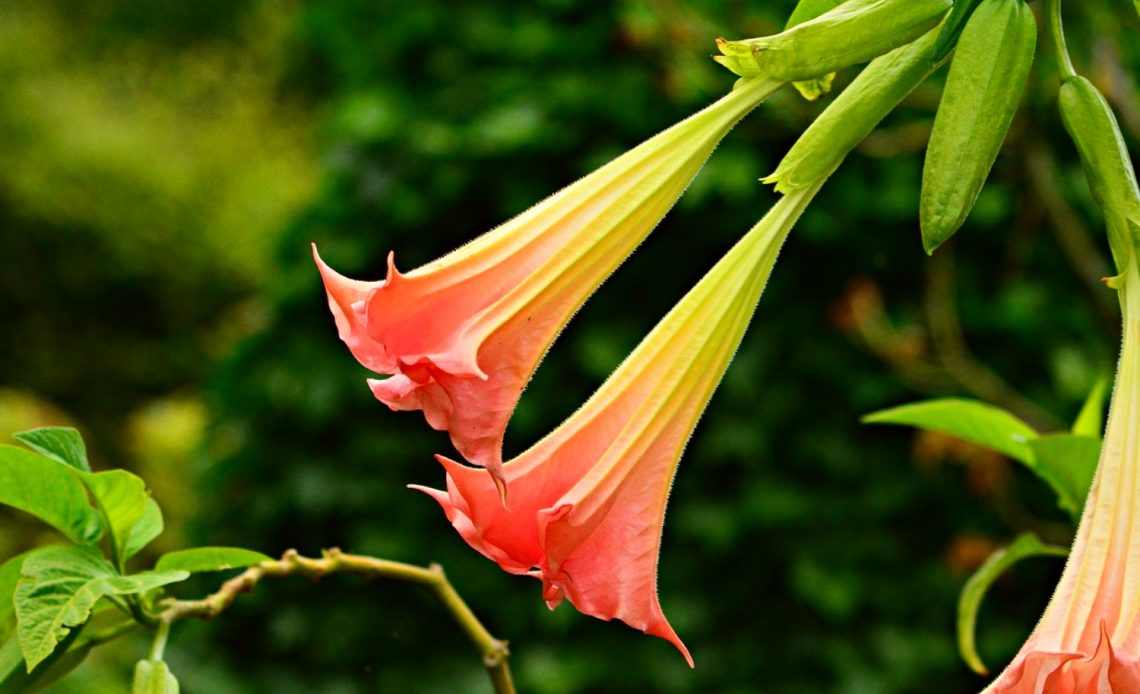

We’re here to help! Wild Yards is a completely free website that is 100% dedicated to helping you create a wildlife-friendly, sustainable yard. Read more
WildYards is reader-supported. When you buy a product through a link on our site, we may earn a comission. Every product is independently selected by our (obsessive) editors and our reviews are unbiased and objective. Read more about our mission or our privacy policy.
Pollinators love to browse a variety of flowers, of all different colors, sizes, and shapes.
If you want to design a garden filled with blooms your local hummingbirds, bees, and butterflies will love, it’s important to include a mixture of flowers.
From open-faced coneflowers and zinnias to cup-shaped peonies and tulips, including a variety of flowers in your landscape keeps things interesting, and encourages pollinators to stick around.
Bell-shaped flowers are another good choice. These flowers offer insects some shelter from the elements and protection from predators as they collect nectar and pollen.
But which bell-shaped flowers should you choose for your garden?
Columbines, bluebells, and lilies of the valley are dainty flowers perfect for tea gardens and cottage-inspired landscapes. Daffodils and foxgloves are classic and colorful, while angel’s trumpet makes an incredible focal point.
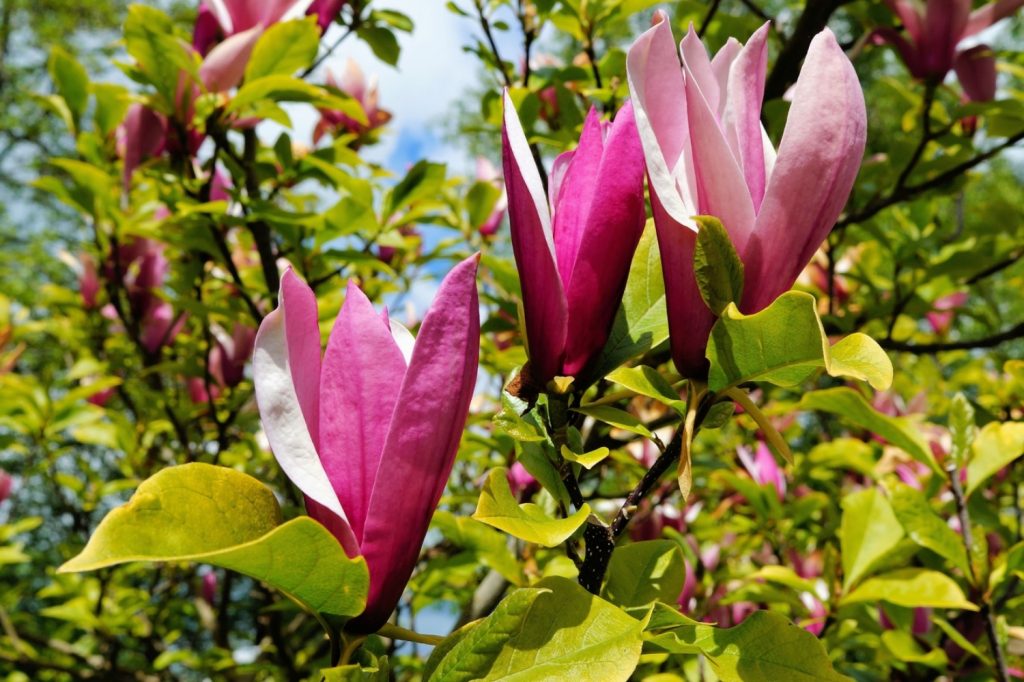
16 Bell-shaped flowers for your garden
Nothing is more relaxing or rewarding than spending time in the flower garden that you grew yourself.
Growing different types of flowers create contrast and, consequently, a more interesting landscape.
Shake things up in your pots, hanging baskets, and raised beds with the help of these gorgeous bell-shaped flowers!
Canterbury Bells
| Scientific name | Campanula medium |
| Growing zones | 4 through 8 |
| Light requirements | Full to partial sunlight |
| Soil preference | Sandy, loamy, clay. Fertile, humusy, and well-draining |
| Maximum size | 2’ to 3’ tall by 1’ to 2’ wide |
Also known as spotted bellflowers, Canterbury bells are upright perennial plants that produce distinctive spotted pink flowers.
Canterbury bells flower from late spring to summer, just in time to feed migrating hummingbirds.
Like elephant ears, these plants can be divided by separating the roots and replanting them.
This easygoing shrub works well as an accent plant for decorating boring corners of your backyard, or along wooded fence lines to add color to the green backdrop.
Foxgloves
| Scientific name | Digitalis |
| Growing zones | 4 through 8 |
| Light requirements | Full to partial sunlight |
| Soil preference | Sandy, loamy. Rich in organic matter and well-draining |
| Maximum size | 2’ to 5’ tall by 1’ to 2’ wide |
Foxgloves are showy and vibrant, and at 2’ to 5’ tall, add drama and height to your mixed flower beds.
If you’re a big fan of cut flowers, don’t forget to plant a few of these perennials. A long-time garden favorite, foxgloves are a big hit with bumblebees and butterflies, too.
Foxgloves flower from spring to early summer. Some hybrid cultivars can bloom twice per year.
These beautiful bell-shaped flowers come in a variety of colors, including shades of white, pink, purple, red, and yellow.
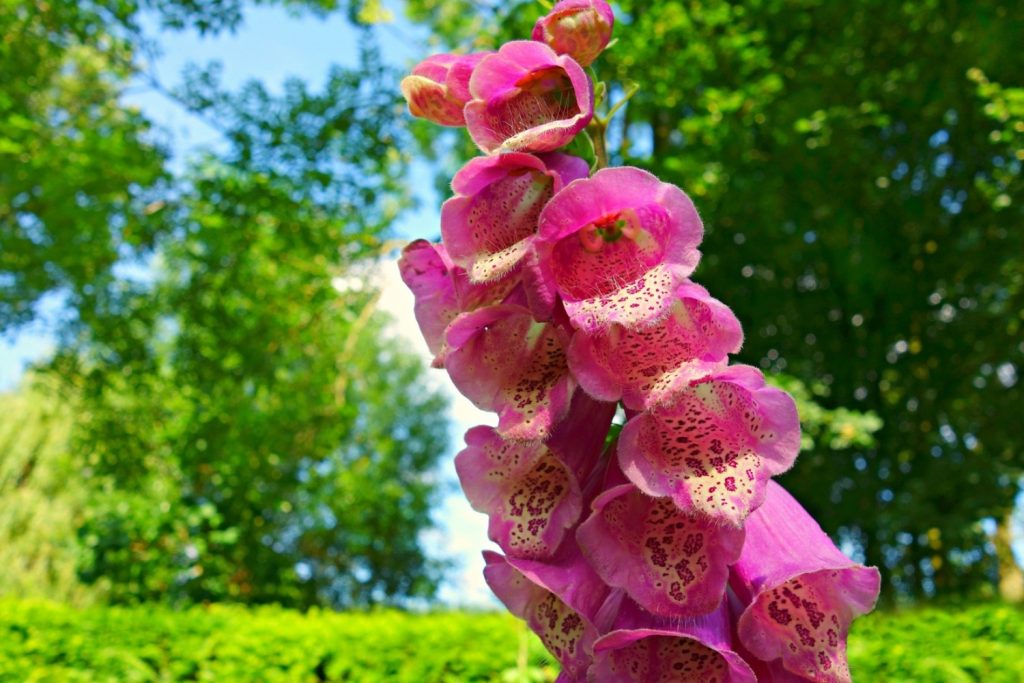
Grape Hyacinth
| Scientific name | Muscari |
| Growing zones | 3 through 9 |
| Light requirements | Full to partial sunlight |
| Soil preference | Sandy, loamy, clay. Moderately fertile and well-draining |
| Maximum size | 6” to 12” tall by 4” to 6” wide |
An adorable low-growing perennial, draw your visitors’ attention to the grape hyacinth’s bell-shaped flowers by growing the plant as a border along flower beds and walkways.
These whimsical flowers are well-suited to container gardens, too. The grape hyacinth looks right at home when planted in pots and window boxes.
These flowers come in shades of white, blue, yellow, and, of course, purple.
Grape hyacinths bloom in early spring, providing pollinators with an early source of food as many other plants are still emerging from their winter dormancy.
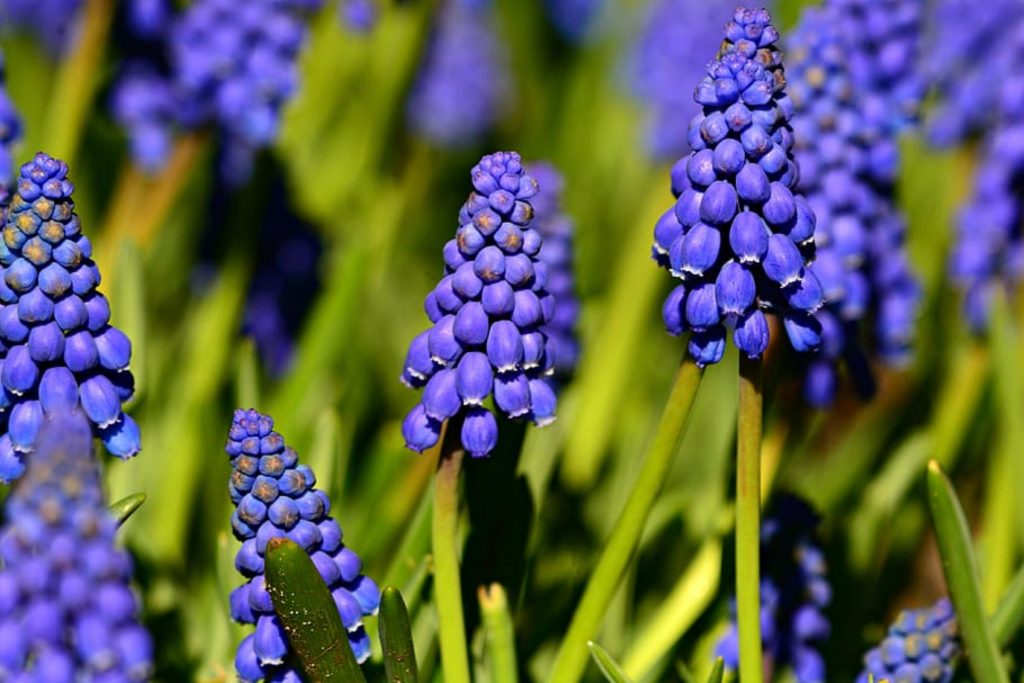
Persian Lilies
| Scientific name | Fritillaria persica |
| Growing zones | 5 through 8 |
| Light requirements | Full to partial sunlight |
| Soil preference | Sandy, loamy, clay. Rich in organic matter and well-draining |
| Maximum size | 2’ to 3’ tall by 1’ to 2’ wide |
This perennial, which blooms in midsummer, grows best in hot, dry environments, where it produces precious bell-shaped flowers in dramatic shades of deep purple, red, and gray.
Some Persian lilies are so saturated, they can appear black.
Persian lilies are deer-resistant. If your local deer herd likes to make a meal of your flower beds, adding these bell-shaped flowers will help deter them.
Use Persian lilies to fill in the gaps in your southwest-inspired landscapes and add height to your succulent garden.
Columbine
| Scientific name | Aquilegia spp. |
| Growing zones | 3 through 9 |
| Light requirements | Full to partial sunlight |
| Soil preference | Sandy, loamy. Fertile, rich in organic matter, and well-draining |
| Maximum size | 1’ to 3’ tall by 1’ to 2’ wide |
Columbines come in all different colors, including blue, yellow, red, purple, pink, and white. Flowers are tubular and framed by five petals, giving them a star shape.
Their somewhat open face makes the columbine a popular choice for pollinator gardens, as bees, butterflies, and hummingbirds can easily find the flower’s nectar.
Plant a row of columbines in front of a row of foxgloves to add depth to your flower beds. Or plant columbines along a picket fence to make your garden feel more inviting.
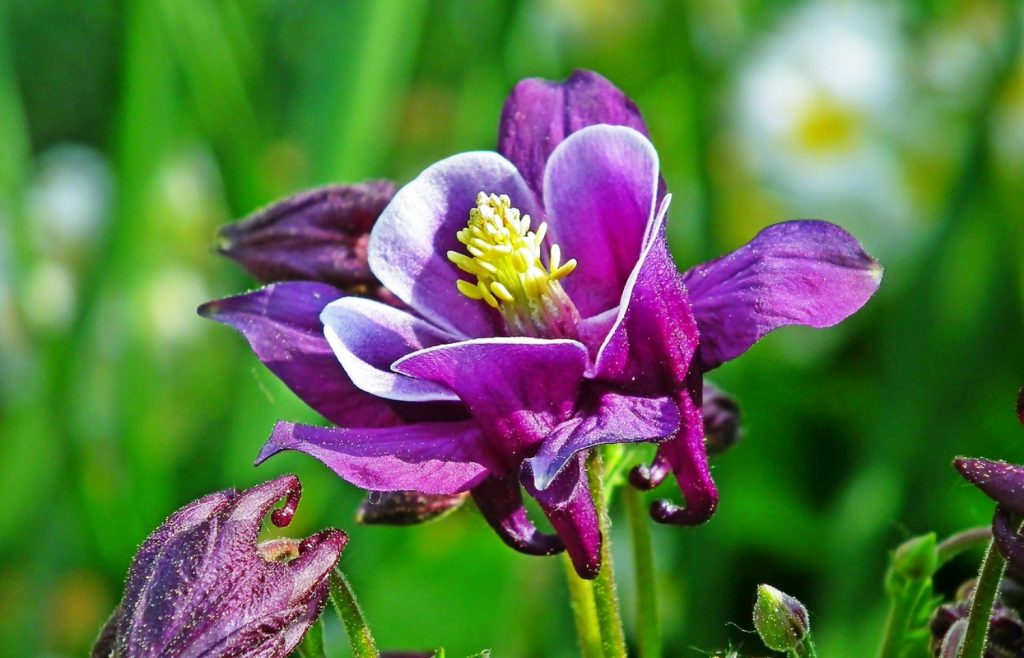
Trumpet Vine
| Scientific name | Campsis radicans |
| Growing zones | 4 through 9 |
| Light requirements | Full to partial sunlight |
| Soil preference | Sandy, loamy, clay. Well-draining |
| Maximum size | 30’+ tall |
Perfect for arbors, trellises, and covering tumble-down fences, trumpet vine can spread more than 30 feet in ideal conditions.
This perennial herbaceous vine produces long bell-shaped flowers in shades of orange and red. Trumpet vines are an excellent source of nectar for hungry hummingbirds.
This plant is extremely drought-tolerant once established and can survive brief periods of flooding, too, as long as it’s planted in well-draining soil.
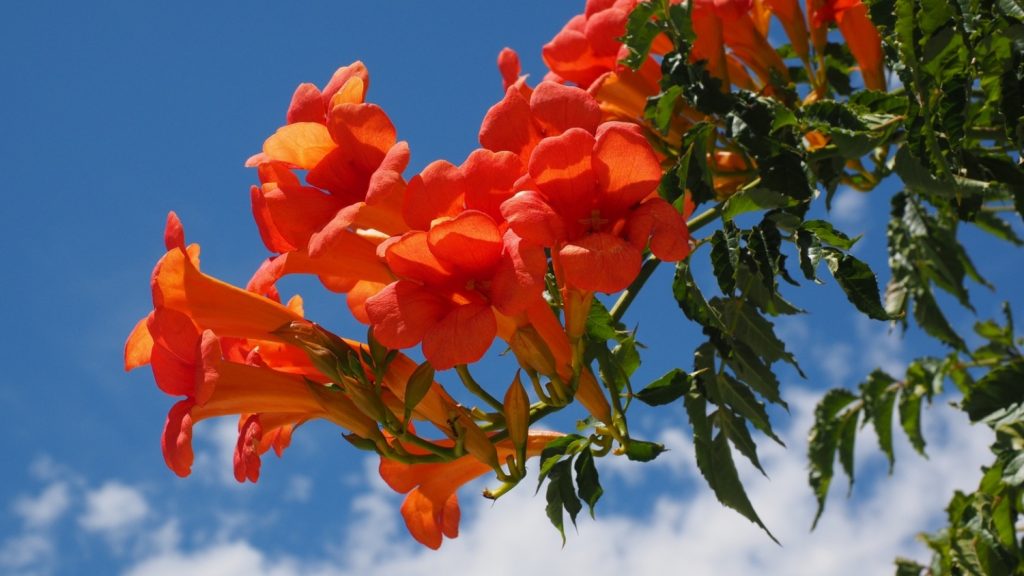
Bluebells
| Scientific name | Hyacintoides non-scripta |
| Growing zones | 5 through 9 |
| Light requirements | Full to partial shade |
| Soil preference | Sandy, loamy, clay. Fertile, rich in organic matter, and well-draining |
| Maximum size | 12” to 20” tall by 6” to 12” wide |
Dainty and delicate, bluebells are a classic mid-sized perennial with iconic bell-shaped flowers.
Bluebells are elegant, yet understated. They look just right when planted amongst wildflowers, like winecups and primroses.
Bluebells can also work in zen gardens to add contrast to greenery, like ferns and elephant ears.
These charming flowers add unpretentious color to any landscape and are so easy to care for.
Just add a few handfuls of compost and horticultural sand to your native soil to improve drainage, and the plants will grow great.
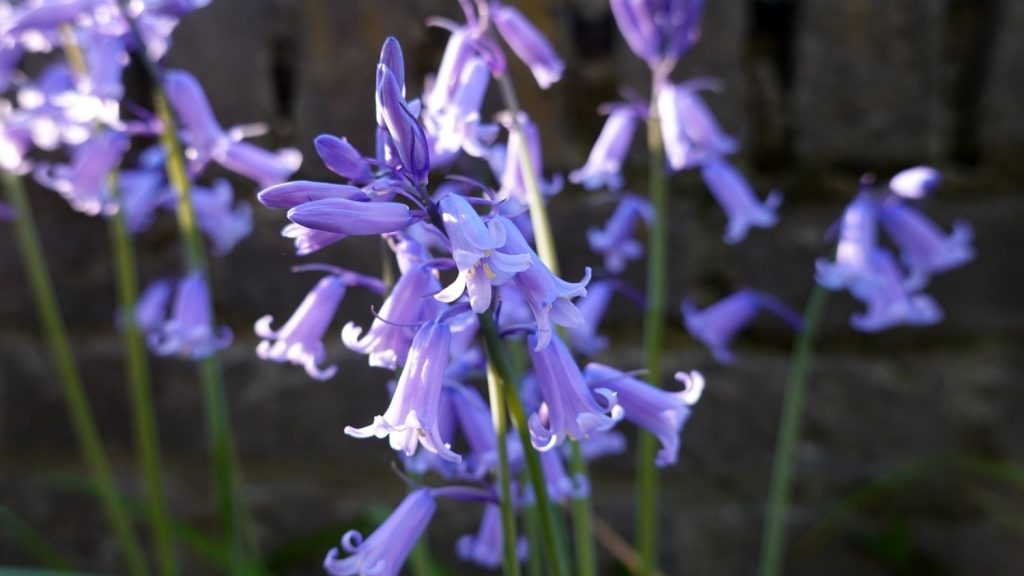
Snowdrops
| Scientific name | Galanthus |
| Growing zones | 3 through 9 |
| Light requirements | Full to partial shade |
| Soil preference | Loamy, rich in organic matter, fertile, moist yet well-draining |
| Maximum size | 4” to 6” tall by 3” to 6” wide |
The scientific name for snowdrops is “Galanthus”, which is taken from two Greek words — “gala” which means milk, and “anthos”, which means flower. The name is a reference to the snowdrop’s creamy coloring.
In addition to their delicate beauty, snowdrops have a delicious perfume reminiscent of honey with notes of almonds.
This perennial plant’s snow-white bell-shaped flowers can be used to create a beautiful border around purple and yellow crocuses, which also bloom at around the same time.
Lily Of The Valley
| Scientific name | Convallaria majalis |
| Growing zones | 2 through 8 |
| Light requirements | Full to partial shade |
| Soil preference | Sandy, loamy, clay. Rich in organic matter, fertile, moist yet well-draining |
| Maximum size | 6” to 12” tall by 12” to 18” wide |
Like snowdrops, the lily of the valley isn’t just known for its white, bell-shaped flowers. It’s also beloved for its delicate fragrance, which is both floral and citrusy.
Because lily of the valley grows best in soils that can be kept uniformly moist, consider amending your native soil with compost or manure before planting.
Sphagnum moss can also be used as moss to prevent rapid hydration loss.
Plant lily of the valley with foamflowers for a monochromatic look, or with bleeding hearts and ferns for color contrast.
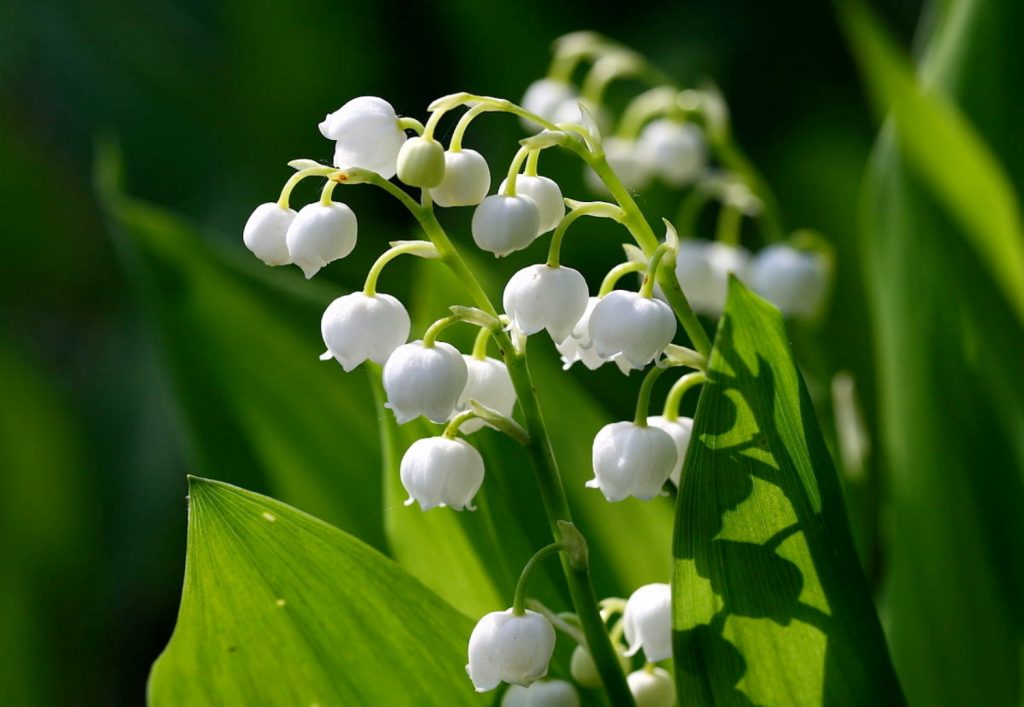
Daffodils
| Scientific name | Narcissus |
| Growing zones | 3 through 9 |
| Light requirements | Full to partial shade |
| Soil preference | Sandy, loamy. Rich in organic matter, moist, yel well-draining |
| Maximum size | 6” to 24” tall by 3” to 6” wide |
Whether you choose yellow, orange, or white daffodils, these cheery bell-shaped flowers are a great way to usher in spring.
Plant daffodils with other perennial bulbs, like tulips and grape hyacinths to create a showy display at the start of the new growing season.
Daffodils are also a beautiful addition to floral arrangements. These flowers can last for days in water.
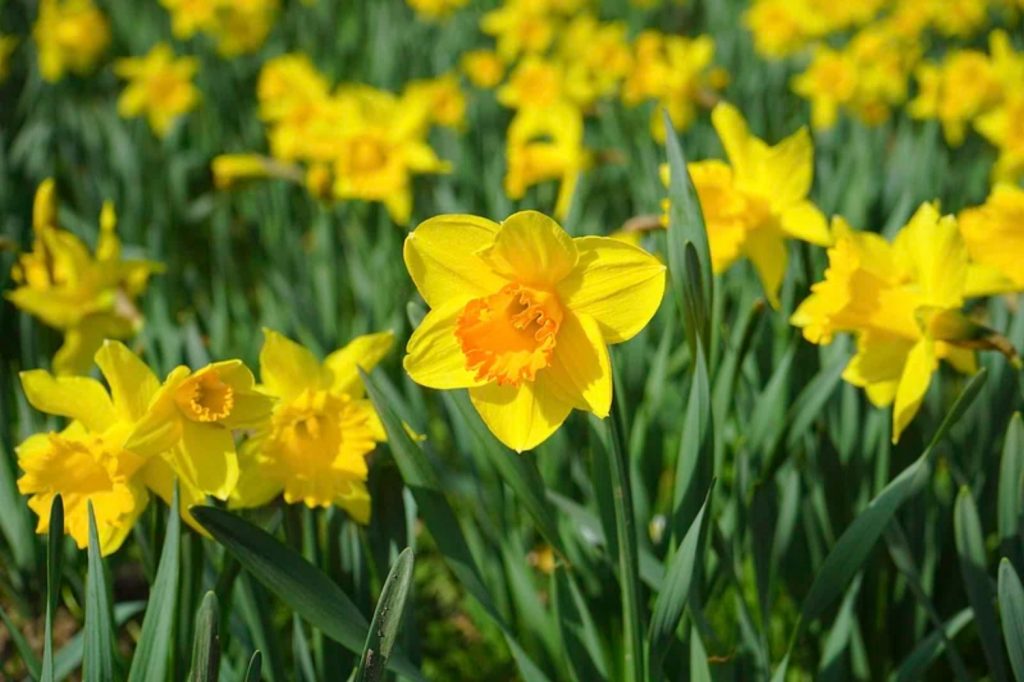
Black-Eyed Susan Vine
| Scientific name | Thunbergia alata |
| Growing zones | 9 through 11 |
| Light requirements | Full to partial sunlight |
| Soil preference | Sandy, loamy, clay. Rich in organic matter, well-draining |
| Maximum size | 30’+ tall |
Black-eyed Susan vine isn’t related to the wildflower of the same name. But it does resemble those flowers, with yellow petals and dark brown to black centers.
These annual vines can be grown as perennials in warm climates, and are often kept as houseplants.
Black-eyed Susan vine flowers from summer to fall, producing bell-shaped flowers that butterflies and moths love to visit.
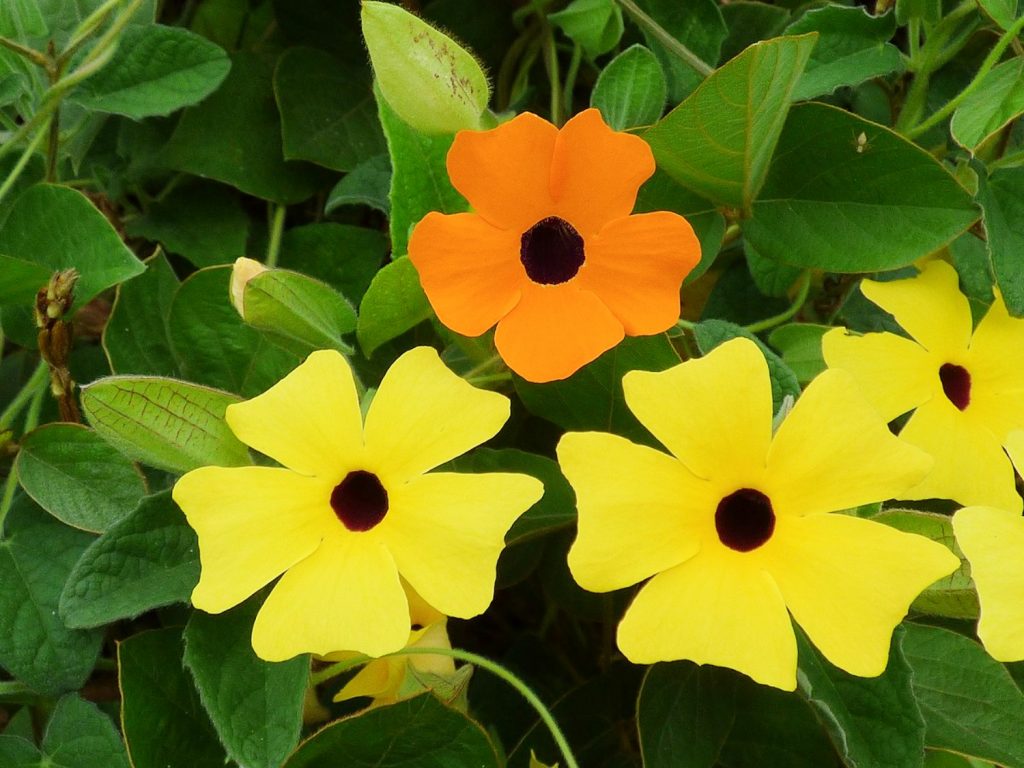
Bells Of Ireland
| Scientific name | Moluccella laevis |
| Growing zones | 2 through 11 |
| Light requirements | Full to partial sunlight |
| Soil preference | Sandy, loamy. Fertile, well-draining |
| Maximum size | 2’ to 3’ tall by 12” to 18” wide |
Interestingly, bells of Ireland are not native to Ireland but instead come from Western Asia.
Usually grown as annuals, bells of Ireland produce long-lasting bell-shaped flowers along tall stalks.
The flowers are typically lime green in color and can be used to add texture to foliage beds.
You can also pair your bells of Ireland with larkspur and snapdragons to create the cut-flower garden of your dreams.
Fuchsias
| Scientific name | Fuchsia |
| Growing zones | 8 through 11 |
| Light requirements | Bright indirect sunlight; morning sun, afternoon shade; partial shade |
| Soil preference | Loamy, rich in organic matter, fertile, well-draining |
| Maximum size | 1’ to 3’ tall by 1’ to 2’ wide |
If color is what you want, then look no further than this bell-shaped flower.
Fuchsias can be found in vivid shades of white, pink, purple, and red, and produce eye-catching flowers with ruffled petals and long filaments.
Grow your fuchsias in pots and window boxes, or use them as companions for geraniums and lobelias in your flower beds.
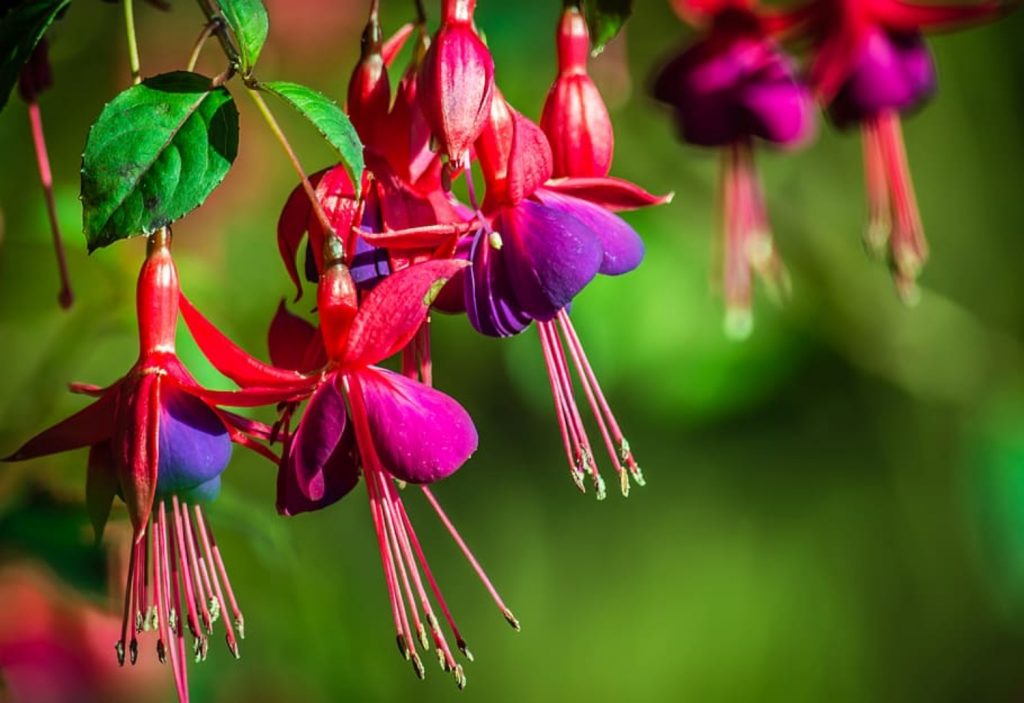
Angel’s Trumpet
| Scientific name | Brugmansia |
| Growing zones | 9 through 11 |
| Light requirements | Full to partial sunlight |
| Soil preference | Sandy, loamy. Rich in organic matter, fertile, and well-draining |
| Maximum size | 10’ to 20’ tall by 6’ to 10’ wide |
Not to be confused with trumpet vine, angel’s trumpet is a small tree that’s perfect for accenting your mixed flower beds.
Angel’s trumpet produces long bell-shaped flowers. Traditionally, angels’ trumpets are orange or white, but yellow, red, and pink varieties can be found, too.
Semi-evergreen, angel’s trumpet should be covered or brought inside when temperatures dip below 40 degrees, as they dislike the cold.
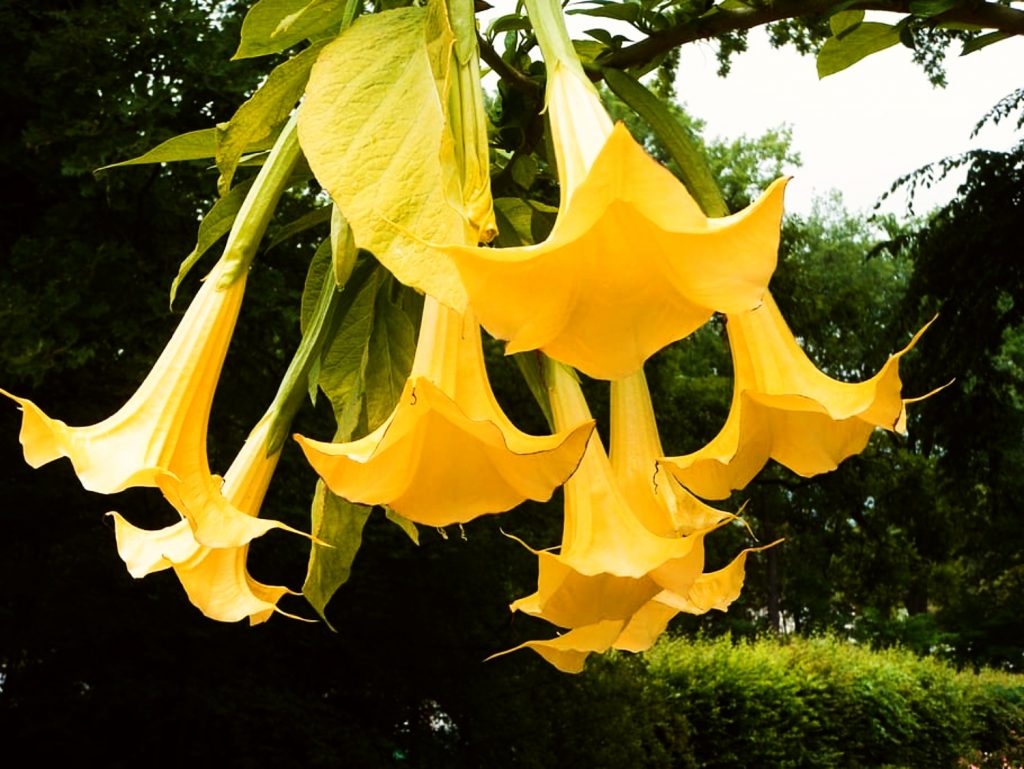
Snake Head Fritillary
| Scientific name | Fritillaria meleagris |
| Growing zones | 3 through 8 |
| Light requirements | Full to partial sunlight |
| Soil preference | Sandy, loamy, clay. Fertile, well-draining |
| Maximum size | 8” to 16” tall by 4” to 8” wide |
Enchanting and otherworldly, the snake head fritillary is an exotic perennial that is also sometimes called the guinea hen flower or frog cup.
Native to Eurasia, the snake head fritillary produces white, pink, and deep purple flowers with a dappling that resembles snake skin.
This plant’s nodding blooms are a natural choice for lining walkways and stepping stones. But plants look just as good in window boxes and as a border for raised beds.
Amaryllis
| Scientific name | Hippeastrum |
| Growing zones | 8 through 11 |
| Light requirements | Bright indirect sunlight; morning sun, afternoon shade |
| Soil preference | Loamy, loose, rich in organic matter. Moist, yet well-draining |
| Maximum size | 18” to 24” tall by 12” to 18” wide |
If you’re new to planting bulb flowers, the amaryllis is one of the easiest, and the most fun, to grow.
Featuring stunning bell-shaped flowers situated at the tips of tall green stalks, amaryllis bloom in late winter to early spring, producing gorgeous red, white, yellow, orange, and green flowers.
Amaryllis grow best when crowded, so they’re an ideal choice for pots and container gardens.
Just be sure to plant your amaryllis in well-draining soil that has been amended with plenty of compost. These flowers are heavy feeders!
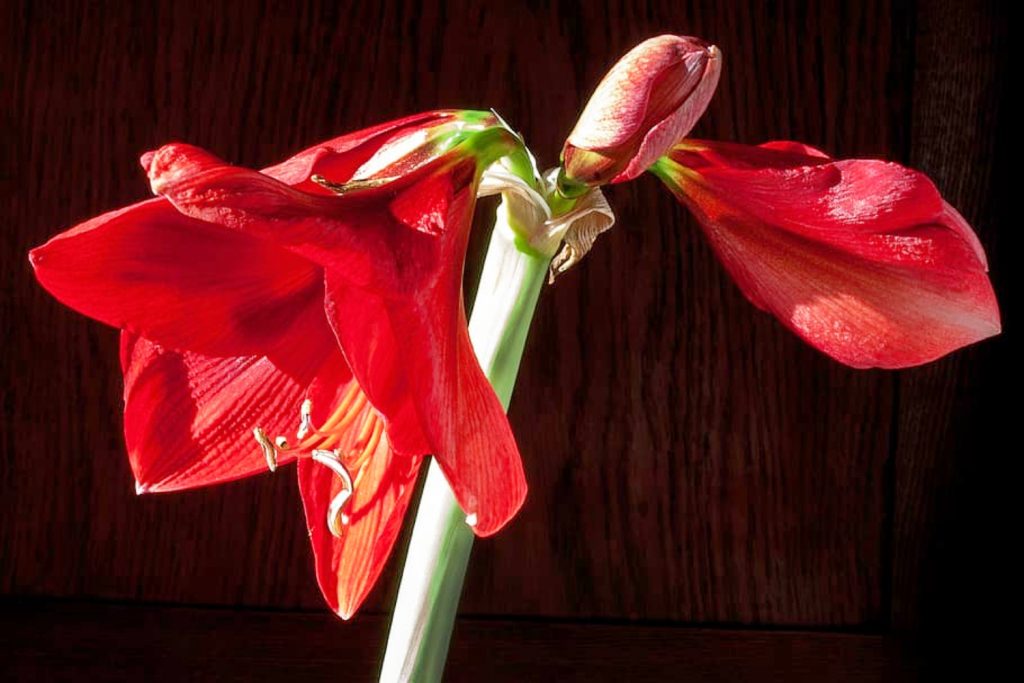
Support pollinators and beautify your landscape with bell-shaped flowers
Research shows bees gravitate toward blue, purple, and yellow flowers, while butterflies prefer yellow, pink, and orange ones.
So when choosing bell-shaped flowers for your garden, be sure to include flowers of many different colors.
This will encourage local pollinators to spend more time in your backyard.
By providing food for bees, butterflies, and hummingbirds, bell-shaped flowers will give you and your guests hours of enjoyment, all while supporting your local ecosystem.
